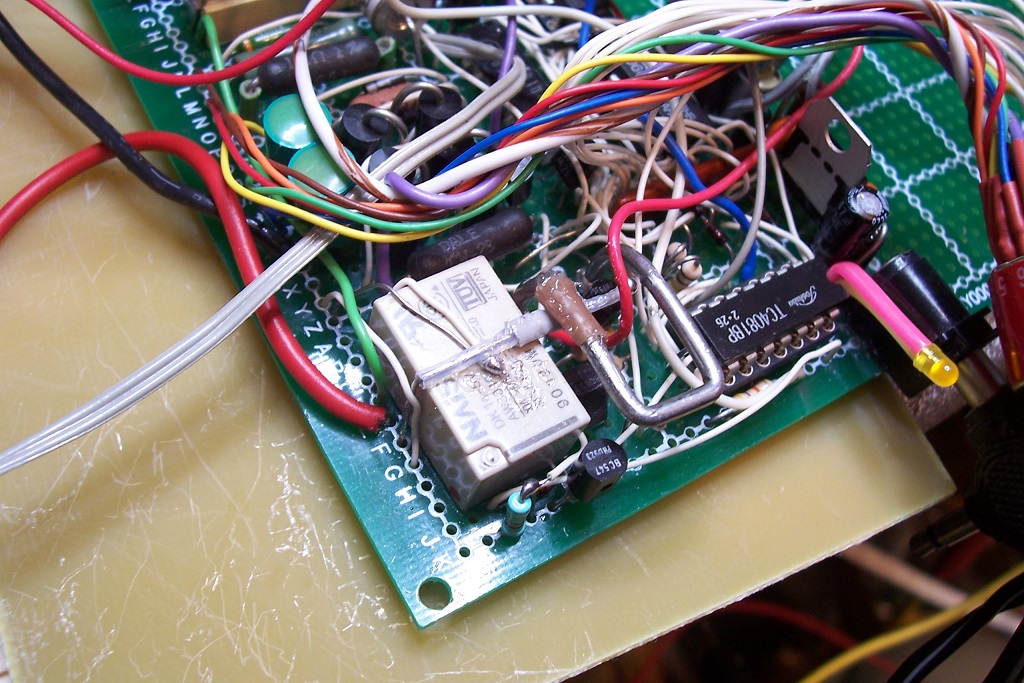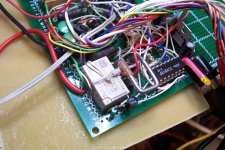I am currently building myself a small, autonomous and easily moveable ammeter.
I already have plenty of current-measuring means, mainly multimeters and also more exotic ones, like a HP428 clone, but I felt the need for another one.
Multimeters generally lack some ranges, and my 7½ digit dreadnought is often used for other purposes.
The one I am building has eight ranges, from 1µA to 10A, and just two terminals.
This means that the 10A shunt needs a relay, because the miniature range selector I used is just good for 1A.
Nothing fancy: just an old 10k pts DPM, some shunts, logic, 4-wire circuitry and a precision 10x amplifier to bring the fsd from 1.0000V to 100.00mV.
The circuit was debugged, and I began the calibration.
At first, everything seemed normal, but I then noticed that the zero of the 10A range was slowly drifting upwards, reaching 5 pts after half an hour.
I was somewhat puzzled, because the conditioning circuit is common to all ranges, and has nothing switched.
All of the other ranges were rock-steady.
I then realized that the relay consuming 0.04A @5V was slowly heating, and heated one side of the 0.01Ω shunt.
When shunts heat due to the current they pass, they do so in a uniform manner, meaning thermoelectric effects tend to cancel, but here only one side was (lightly) heated, and this was sufficient to cause problems.
As the resolution is 10µV, 5 pts translate into 50µV.
As a result, I included two compensating junctions, made from kovar/copper.
One is on the top of the relay, and the other on its left side:

The result was a zero perfectly stable from the switch-on instant to ∞.
This shows that thermoelectric effects are not confined to ultra-precision circuits: they can show up in the most mundane and ordinary situations too
I already have plenty of current-measuring means, mainly multimeters and also more exotic ones, like a HP428 clone, but I felt the need for another one.
Multimeters generally lack some ranges, and my 7½ digit dreadnought is often used for other purposes.
The one I am building has eight ranges, from 1µA to 10A, and just two terminals.
This means that the 10A shunt needs a relay, because the miniature range selector I used is just good for 1A.
Nothing fancy: just an old 10k pts DPM, some shunts, logic, 4-wire circuitry and a precision 10x amplifier to bring the fsd from 1.0000V to 100.00mV.
The circuit was debugged, and I began the calibration.
At first, everything seemed normal, but I then noticed that the zero of the 10A range was slowly drifting upwards, reaching 5 pts after half an hour.
I was somewhat puzzled, because the conditioning circuit is common to all ranges, and has nothing switched.
All of the other ranges were rock-steady.
I then realized that the relay consuming 0.04A @5V was slowly heating, and heated one side of the 0.01Ω shunt.
When shunts heat due to the current they pass, they do so in a uniform manner, meaning thermoelectric effects tend to cancel, but here only one side was (lightly) heated, and this was sufficient to cause problems.
As the resolution is 10µV, 5 pts translate into 50µV.
As a result, I included two compensating junctions, made from kovar/copper.
One is on the top of the relay, and the other on its left side:
The result was a zero perfectly stable from the switch-on instant to ∞.
This shows that thermoelectric effects are not confined to ultra-precision circuits: they can show up in the most mundane and ordinary situations too
